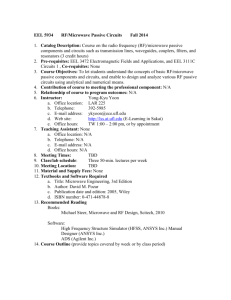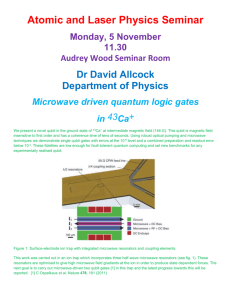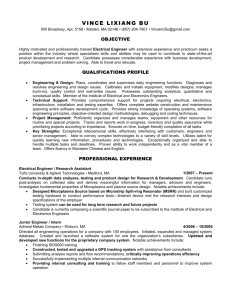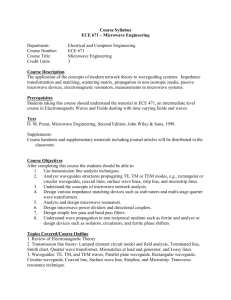PPTX
advertisement
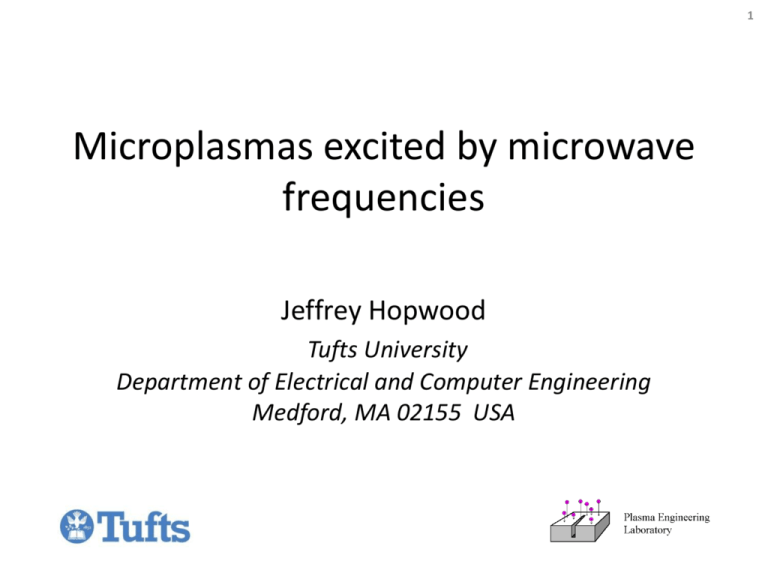
1 Microplasmas excited by microwave frequencies Jeffrey Hopwood Tufts University Department of Electrical and Computer Engineering Medford, MA 02155 USA Tufts University Tufts Harvard M.I.T. Tufts University 4 Acknowledgments • National Science Foundation – CBET-0755761 • Department of Energy – DE-SC0001923 • DARPA – Microscale Plasma Devices program – FA9550-12-1-0006 • Schlumberger-Doll Research Corp. • • • • • Alan Hoskinson, Asst. Research Prof. Shabnam Monfared, Postdoc Chen Wu, PhD candidate Stephen Parsons, PhD candidate Naoto Miura, PhD’12 • • Jun Xue, PhD’10 • • Applied Materials Felipe Iza, PhD’04 • • National Instruments, Tokyo Professor, U. Loughborough, UK Undergraduate Research Assistants: Michael Grunde, Mical Nobel, Kevin Morrissey, and Atiyah Ahsan 5 Outline • Overview and Motivation • Microplasmas driven at microwave frequency – Principle of operation – Diagnostics • • • • Microplasma deposition using C2H2 + He Arrays of microplasmas (1-D and 2-D) Conclusion Gas Sensors based on microplasma 6 Outline • Overview and Motivation • Microplasmas driven at microwave frequency – Principle of operation – Diagnostics • Microplasma deposition using C2H2 + He • Arrays of microplasmas (1-D and 2-D) • Conclusion 7 Motivation • Historically, technology has been introduced as a batch process • Simple and robust, but slow and costly www.inkart.com 8 Motivation • Continuous processing follows as technology advances • High volume production and lower costs 9 Motivation stories.mnhs.org Batch Processing www.orioncoat.com Continuous Processing 10 Motivation amat.com Single wafer per batch High value, low throughput -chips- Single panel per batch Low value, low throughput!!! -panels- 11 Motivation 12 Goal: Atmospheric Pressure Roll Coating cleaning deposition encapsulation Roll-to-roll materials processing at 1 atm using microplasma arrays 13 Challenges • Plasma Temperature – Typically atmospheric plasmas are very hot and incompatible with low-cost substrates • Plasma Stability – Ionization overheating instability causes the atm plasma to constrict into a small arc – Negative resistance difficult to operate in parallel – Pulsed plasmas are mostly ‘off’ when operated in kHz • Energy flux – Plasma processing is driven by ion kinetic energy – Difficult to achieve k.e. due to ion collisions at 1 atm. 14 Outline • Overview and Motivation • Microplasmas driven at microwave frequency – Principle of operation – Diagnostics • Microplasma deposition using C2H2 + He • Arrays of microplasmas (1-D and 2-D) • Conclusion 15 Introduction Microwave Split Ring Resonator 20-200 mm discharge gap 1.8 GHz 0.9 GHz E-fields in split-ring resonators no plasma 25 um discharge gap |E|~107 V/m at 1 W 16 Microwave frequency Coplanar, Capacitively-Coupled Plasma 17 Massive ions do not respond to microwave electric fields (w > wpi) No sputtering of the electrodes. + + +/- -/+ + + …electrons are partially confined within the plasma: Average displacement < 10 mm @ 1 GHz 18 The role of frequency simulations by F. 500 um University, 500 um UK 500 um Iza,Loughborough 10 MHz 1.0 GHz F Iza et al, Eur. Phys. J. D 60, 497–503 (2010) 19 Current-Voltage Behavior • Ignition: Vpk = 150 volts • Normal Operation: Vpk = 20 v (Ipk = 10 mA, Pave = 1 W) no plasma ignition 1 atm, non-flowing argon gas, 1 GHz 1 – microplasma ignition 2 – microplasma attaches to ground 3 – microplasma retreats to gap 20 Microplasma Stability of the split-ring resonator – HFSS model Power reflected from resonator Power absorbed by the plasma Power losses Arc (Rp~10W) Extinguished (Rp∞) Rp = Plasma resistance ~ 1/ne Low voltage + High frequency = 2000+ hours of operation 5-element microplasma array -- 1 atm argon, 0.4 W, copper electrodes. Day 0 (0 hrs.) Day 10 (240 hours) Day 23 (550 hours) Day 44 (1030 hrs.) Day 58 (1370 hrs.) Day 85 (2020 hrs.) 21 Close-ups: 2000 hours of operation • The dielectric and electrode structures are unaffected • Copper surfaces are discolored, with some black coating likely due to carbon deposition (from PTFE circuit board) ground 0 hours After 2020 hours ground electrode gap= 100mm limiter covers resonators 22 resonator 23 Basic Properties • ne ~ 2x1014 cm-3 (1 W, 1 atm) Torch: 4x1014cm-3 @ 100W* DBD/jet: ~1011cm-3 ** MHCD: ~1015cm-3 *** • Trot = 400 K (Ar + 1%N2); 600K (air) • Pressure: 0.01 Torr – 2 atm – air, nitrogen, oxygen, argon, helium, … • • • • • • Power: 0.15 – 15 W Velectrode ~ 20 v (DC microcavity and DBD ~ 300 v, RF jet ~ kV) No gas flow required for stabilization No ballast (resonantly stabilized) No dielectric barrier required No matching network (frequency tuning) *Spectrochimica Acta Part B 54 1999. 1253-1266 **Eur. Phys. J. D 60, 489–495 (2010) ***J. Appl. Phys., Vol. 85, No. 4, 15 February 1999 Microplasma Properties (Ar @ 1 atm) Electron density (Stark broadening of Hβ) Gas temp. (OH rotational fitting) Ne = 1015 cm-3 Ne = 5x1013 cm-3 0.15 W 15 W Excitation temp. (Boltzmann plot) N. Miura and J. Hopwood, EPJ D 66(5), 143-152 (2012). 24 25 Spatially-Resolved Gas Temperature and Ar Metastable Density by Scanned Laser Diode Absorption (LDA) 801.4 nm Arm - 1s5 26 Ar(1s5) + hn(801.4nm) Ar(2p8) Laser Intensity I0 : Incident N l: Wavelength kl It : Transmitted (Absorbed) I ln 0 It Integral Line integrated density: Nl Absorption line shape 8 gi c kl d l 4 l0 g k Aki l: Wavelength Broadening Gas Temperature: Tg 27 Spatially-Resolved Gas Temperature and Ar Metastable Density by Scanned Laser Diode Absorption (LDA) 801.4 nm Arm - 1s5 1 atm, Ar N. Miura and J. Hopwood, J.Appl. Phys., Jan 2011. 1 atm, Ar 28 Spatially-resolved Gas Temperature and Ar Metastable Density by Laser Diode Absorption (LDA) Ar(1s5) = 1013 cm-3 Abel inverted data N. Miura and J. Hopwood, J.Appl. Phys., Jan 2011. 29 Higher absorbed power results in more metastable depletion from the core region and higher gas temperatures 30 High Power Data (9 W) argon at 1 atm 31 Depletion of species at ‘high’ power • Ionization or dissociation by centrally-peaked electron density – – Arm + e Ar+ +2e OH + e O + H + e • Hot core has a depleted neutral density? • Hot core has reduced resonant radiation trapping??? – Arr Ar + hn Arr Arm hn Ar 32 Outline • Overview and Motivation • Microplasmas driven at microwave frequency – Principle of operation – Diagnostics • Microplasma deposition using C2H2 + He • Arrays of microplasmas (1-D and 2-D) • Conclusion 33 Experimental Configuration glass substrate spacers plasma source gas plenum plexiglas enclosure (vented to atm) helium helium + 1% C2H2 34 Ion Flux vs. SRR-to-substrate distance stainless steel probe (r=75um, l=500um); probe length is deconvolved 1E+18 He Ion Flux (cm-2s-1) 1E+17 typ. ICP ion flux 1E+16 1E+15 1E+14 0 0.5 1 1.5 2 2.5 Distance above the SRR electrodes (mm) Hard DLC, impervious to acetone Soft films, removed by acetone Notes: 1 liter/min helium, 2 watts of microwave power Film topology and deposition rate Diamond tip induced delamination optical AFM AFM Time Power Spacer Total flow C2H2 fraction Deposition Rate 30 s 3.5 W 270 um 1000 l/min 0.05% 7 um/min. 35 36 Deposition Rates Typ. 4-7 mm/min. 30 sec. 37 Grain size methodology • Contrast enhancement followed by watershed segmentation • Resulting grain sizes typically follow a normal distribution 38 Grain Size • Smaller grains at the peripheral regions • Weakly dependent on concentration • Independent of flow (i.e., gas residence time) unlikely to be gas-phase nucleation of particles 1 mm x y 1 mm 39 Raman Spectroscopy • D and G peaks typically observed for both DLC and polycrystalline graphite • D (1360 cm−1) and G (1582 cm−1) peaks are present • Significant fluorescence from glass substrate 40 DLC Observations • Typically, DLC film deposition requires ion bombardment energy of ~100 eV (e.g., low pressure PECVD) • 1 atm: frequent ion-neutral collisions limit ion energy < 1 eV! • Two possibilities for energetic deposition at 1 atm: 100 eV + 1 eV + 1 Pa + + + + + + 1 atm Ar* ~ 11.5 eV * Very high ion fluxes: energy flux = ion flux * ion energy * * * * * * + * * * * * * Microplasma ion flux is 5x1017 cm-2s-2 25x that of an ICP or DBD Energy delivered by metastable states: Ar*Ar + energy Microplasma [Arm] is >1013 cm-3 ~100x that of an ICP or DBD * 41 Thorton’s view on (ion) energy Zone Model increasing substrate energy (temp.) increasing ion (or sputtered neutral) energy 42 Outline • Overview and Motivation • Microplasmas driven at microwave frequency – Principle of operation – Diagnostics • Microplasma deposition using C2H2 + He • Arrays of microplasmas (1-D and 2-D) • Conclusion 43 Goal: plasma processing of flexible substrates at 1 atm Problem: ½ wavelength ~ plasma size (usually) 44 A scalable geometry Split-ring resonator Quarter-wave resonator V/I = 50 W 45 Single Resonator 1D array • Resonant power sharing allows operating an array from a single microwave source • Each microplasma is stabilized by it’s resonator Resonant power sharing 60 quarter-wave resonators: 75mm long Wu, Hoskinson, and Hopwood, Plasma Sources Science and Technology 20, 045022 (2011). 46 Coupled microwave resonators matched resonators share power from a single power source Thumb Piano Five Microwave Resonators Coupled Mode Theory and Simulation A single, driven resonator shares energy very efficiently with other identical resonators according to CMT: The amplitude of resonator m changes in time due to… Damping/energy loss (decreases) Energy input (increases) Energy coupling from all other resonators, n≠m. (increases) 47 Coupled Mode Theory and Simulation Assume identical resonators : wm w0 and m o Let the input be sinusoidal : F (t ) Aeiwt Giving : a single input k12 k13 0 a1 F wo w io a 0 k w w i k 12 o o 12 2 k13 k12 wo w io a3 0 0 k 13 See: H. A. Haus and W. Huang, Proc. IEEE 79, 1505 (1991) and A. Karalis, J. D. Joannopoulos and M. Soljačić, Ann. Phys. 323, 34 (2008). Amplitude of mth resonator A system of p resonators results in a p x p eigenvector/eigenvalue problem (F0) The p eigenvalues are the resonance frequencies of the coupled resonator system. The p eigenvectors provide the amplitudes of each resonator. 48 49 C. Wu, A. Hoskinson, J. Hopwood, Plasma Sources Sci Technol, 2011 50 Input port 88 resonators Dielectric layer Ground plane er = 10 Note: l/2 = 9 mm! 51 Array Stability • Operation of (micro) plasmas in parallel is difficult due to negative differential resistance • Any perturbation causes one microplasma to take more current at a reduced voltage • Three solutions – Ballast resistors – Transient discharges (capacitive ballast) – Strongly coupled resonators 52 Array Stability Parallel Operation of Microplasmas (DC) Si v H.V. Ballast resistances formed in lightly doped Si 53 Array Stability Parallel Operation of Microplasmas (DBD) A.C. J. G. Eden et al. J. Phys. D: Appl. Phys. 39 (2006) R55–R70 Ballast capacitances formed by a dielectric layer 54 Array Stability Parallel Operation of Microplasmas (DBD) Transient plasma propagation is shown by 2D maps of the optical emission [1] from a 10*10 pixel segment of the DBD microcavity microplasma array plotted in false color. The temporal evolution of the initial burst of the emission in argon at f =10 kHz, p=750torr, and Vpp=780 V is shown. (Dt=200 ns) J. Waskoenig, D. O’Connell, V. Schulzvon der Gathen, J. Winter, S.-J. Park, and J. G. Eden, “Spatial dynamics of the light emission from a microplasma array”, Appl. Phys. Lett. vol. 92, 101503, 2008 Array Stability 1D microwave resonator array • Ignites uniformly on central resonators, then expands to outermost resonators (~ 20 ns) • Continuous operation after ignition • Much faster than DBD arrays (~ 200ns) 50 Torr 55 Array Stability 1D microwave resonator array 56 57 Dimensional Scaling: 2D arrays 58 2D Arrays 59 2D microplasma array (5x5) resonator ends 5 mm ground strip Teflon spacer 5 mm 750 Torr argon 472 MHz 5.9W 150 mm See: Alan Hoskinson and Jeffrey Hopwood, Plasma Sources Science and Technology 21 052002 (2012). 60 Conclusion • A stable high-density microplasma can be sustained by <1 W of microwave power at low gas temperature - operation for 2000+ hours • DLC deposition is possible at 1 atm - low particle energy, but high energy flux • Arrays of microplasmas are possible using a single microwave source - power sharing among resonators stabilizes the parallel cw operation of discharges • Stable microplasma arrays may lead to roll coating at 1 atm 61 Questions 62 Gas Chromatography and Emission Spectroscopy using a Microplasma • Application: sensing sulfur compounds in natural gas and oil in the field • Problem: differential thermal detectors used with low-cost gas chromatographs are insensitive to H2S. • Solution: flow the effluent of a gas chromatograph through a microplasma and measure the emission spectra vs. time. Emission Spectrometry Configuration : 700 Torr 0.3 or 1.0w 500 ppm methane (Airgas) 500 ppm n-butane (Airgas) 515 ppm carbon dioxide (Airgas) 100 ppm hydrogen sulfide (Scott) Hoskinson and Hopwood, JAAS 26(6), 1258 – 1264 (2011) DL ~ 2 ppm CH 431nm Results: CH4 and C4H10 DL ~ 3 ppm O – 777nm Results: C02 DL ~ 0.7 ppm S – 924 nm Results: H2S Results: with 0.3% air contamination a surrogate for a device in the field DL(CH4): 2 ppm 10 ppm DL (H2S): 0.7 ppm 2 ppm 68 GC Demonstration Synthetic natural gas Microplasma + OES http://en.wikipedia.org/wiki/Gas_chromatography GC demonstration GC • • • • • Lab-built gas chromatograph @ 120 C Divinylbenzene 4-vinylpyridine-coated column Helium flow: 6 mL /min. @ 1 atm No make-up gas 2 mL sample injection: 10% synthetic natural gas in helium Hoskinson and Hopwood, JAAS 26(6), 1258 – 1264 (2011) 70 Commercial Gas Sensors using Microplasma and OES 71 Gas Sensors • Improvement on thermal conductivity detection for field-portable sensors through separation in time and emission wavelength Conclusion • A stable high-density microplasma can be sustained by <1 W of microwave power at low gas temperature - operation for 2000+ hours • DLC deposition is possible at 1 atm - low particle energy, but high energy flux • Arrays of microplasmas are possible using a single microwave source - power sharing among resonators stabilizes the parallel cw operation of discharges • Stable microplasma arrays may lead to roll coating at 1 atm 72
